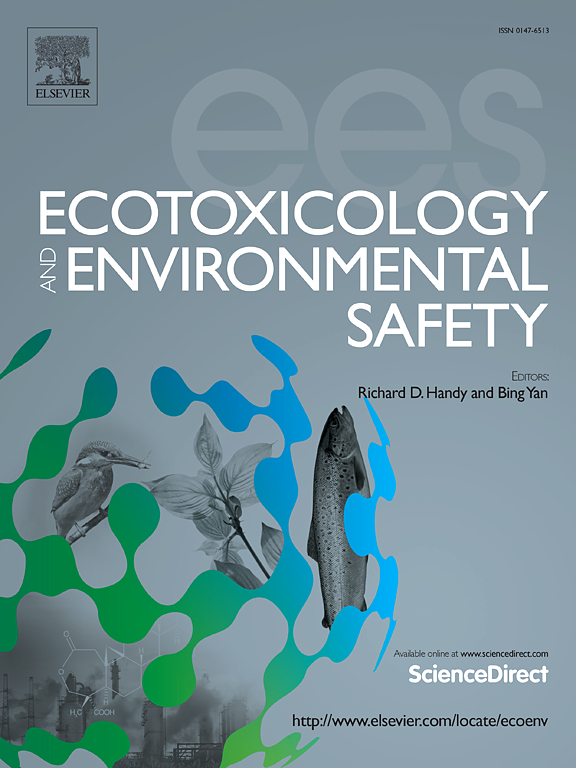Phytoremediation of OTC-Cu/Zn contaminated sediment: Synergetic removal mechanism and microbial community response
IF 6.2
2区 环境科学与生态学
Q1 ENVIRONMENTAL SCIENCES
引用次数: 0
Abstract
Antibiotics and heavy metals (HMs) from aquiculture enter waters and eventually sink into sediments. However, sediments carrying excessive contaminants can become a source of contamination. Macrophytes are frequently employed to treat water contaminated with HMs due to their adaptability, rapid growth rate, and ability to extract contaminants. In this study, oxytetracycline (OTC), and copper (Cu)/zinc (Zn) were chosen to be the target contaminants of antibiotics and HMs in the sediment. A pot experiment was conducted to investigate the phytoremediation effect of two types of macrophytes, Canna indica and Iris pseudacorus. The removal percentages of OTC, Cu, and Zn range from 93.6 % to 97.6 %, 67.4–86.0 %, and 69.8–82.9 % from the sediment, respectively. Adding Cu/Zn facilitated the decomposition of OTC in the sediments, while the presence of OTC transformed Cu/Zn into a more stable form. Both macrophytes extracted HMs mainly through roots accumulation. Higher concentrations of bioavailable forms of Cu/Zn in sediments inhibited plant growth and development, while lower concentrations promoted that. The inhibitory of leaf chlorophyll a+b synthesis by various contaminant treatments showed that OTC>OTC-HMs>HMs and the stimulation of carotenoid synthesis indicated HMs≥OTC-HMs≥OTC. The dehydrogenase (DHA) activities, microbial diversity and abundance in sediment were severely inhibited by HMs, and the inhibition was alleviated by OTC-HMs with C. indica. Proteobacteria, Actinobacteria, and Firmicutes were the dominant bacterial phyla. This study expands the understanding of phytoremediation potential and outlines their physiological and microbial responses to combined antibiotics-HMs.
OTC-Cu/Zn污染沉积物的植物修复:协同去除机制和微生物群落响应
水产养殖中的抗生素和重金属(HMs)进入水体并最终沉入沉积物。然而,含有过量污染物的沉积物可能成为污染源。由于其适应性强、生长速度快、提取污染物的能力,大型植物经常被用来处理被HMs污染的水。本研究选择土霉素(OTC)和铜(Cu)/锌(Zn)作为沉积物中抗生素和HMs的目标污染物。通过盆栽试验,研究了美人蕉和鸢尾这两种大型植物的植物修复作用。沉积物中OTC、Cu和Zn的去除率分别为93.6 % ~ 97.6% %、67.4 ~ 86.0 %和69.8 ~ 82.9 %。Cu/Zn的加入促进了沉积物中OTC的分解,而OTC的存在使Cu/Zn转化为更稳定的形态。两种植物主要通过根系积累提取HMs。沉积物中Cu/Zn的生物可利用形态高浓度会抑制植物的生长发育,而低浓度则会促进植物的生长发育。不同污染物处理对叶片叶绿素a+b合成的抑制表明,OTC>OTC-HMs>HMs;对类胡萝卜素合成的刺激表明,HMs≥OTC-HMs≥OTC。培养基对底泥中DHA活性、微生物多样性和丰度均有明显的抑制作用,而含有籼稻的otc -培养基对底泥的抑制作用有所缓解。变形菌门、放线菌门和厚壁菌门是优势菌门。本研究扩展了对植物修复潜力的理解,并概述了它们对抗生素- hms联合治疗的生理和微生物反应。
本文章由计算机程序翻译,如有差异,请以英文原文为准。
求助全文
约1分钟内获得全文
求助全文
来源期刊
CiteScore
12.10
自引率
5.90%
发文量
1234
审稿时长
88 days
期刊介绍:
Ecotoxicology and Environmental Safety is a multi-disciplinary journal that focuses on understanding the exposure and effects of environmental contamination on organisms including human health. The scope of the journal covers three main themes. The topics within these themes, indicated below, include (but are not limited to) the following: Ecotoxicology、Environmental Chemistry、Environmental Safety etc.

 求助内容:
求助内容: 应助结果提醒方式:
应助结果提醒方式:


